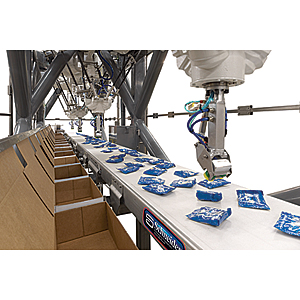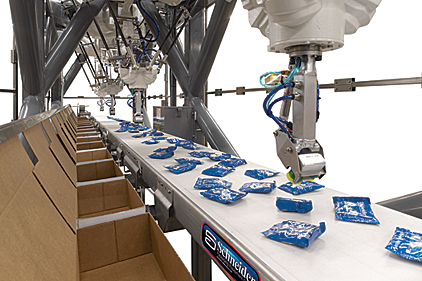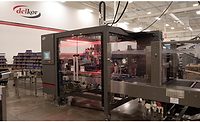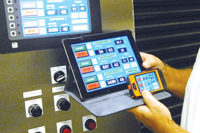As a proliferation of new brands and flavors continues to hit the market, the beverage industry also has experienced an influx of new package styles and designs to help those products stand out on the shelf. “We are seeing a proliferation of new container styles as well as different sizes and styles of multi-packs to appeal to multiple market niches,” says Bryan Sinicrope, vice president of sales and marketing for A-B-C Packaging Machine Corp., Tarpon Springs, Fla.

|
Among those trends is the growth of the craft beer market, which has led to an increase of glass bottles in six-pack carriers, he adds. But as these different packages enter the market, packaging equipment, like case packers and wrappers, needs to evolve as well.
“The beverage market is driven by innovation, and manufacturers are looking for machinery that offers the flexibility to accommodate new package styles and case/tray packs,” Sinicrope says.
Barry Rinaldi, director of business development for Schneider Packaging, Brewerton, N.Y., adds that flexible packaging, such as stand-up pouches and bags, recently has increased in popularity but is not without its own obstacles.
“The new flexible packaging products bring a new set of challenges to secondary packaging,” he says. “Stand-up pouches often have unique shapes that create air pockets in the secondary package, which leads to larger case sizes and inefficiencies in unit loads. However, several stand-up pouch designs lend themselves to nesting inside the secondary packaging by alternating the pack pattern.”
John Kalkowski, marketing director for St. Paul, Minn.-based Delkor Systems Inc., notes that in addition to stand-up pouches, lightweighting of rigid primary packages like plastic and glass bottles continues to impact the industry and its secondary packaging operations.
“While the material reductions reduce weight, this also means the secondary packaging must supply more protection and structural support during shipping,” he says. “Brand owners don’t want the shipping containers to cost any more. In fact, they would also like to reduce material usage in this area, too. Meanwhile, retailers are pushing for shelf-ready containers that improve product rotation, cut labor costs, and provide shelf impact.”
Up to speed
As beverage manufacturers adjust to material reduction and various packaging style trends, they will need enhanced automation to integrate with their factory automation systems as they continue to work toward reduced costs, increased efficiencies and increased speed, A-B-C Packaging’s Sinicrope says.
He adds that addressing customer needs is a top priority for A-B-C Packaging, and it fulfills those needs through modifications to programming, machine infeeds, and staging or packing modules, but all updates are designed to streamline the operations.
“We work with customers to make the most efficient and cost-effective machine for the job, and in some cases, we can suggest a different technique to save time and money for our customer,” Sinicrope says.
Schneider Packaging’s Rinaldi notes that in order for original equipment manufacturers (OEMs) to meet increased speed and nesting requirements, they are implementing robotics to direct products in the cases. In its portfolio, Schneider Packaging utilizes its robotic vertical case loader (RVCL) and horizontal/vertical case packer (HVCP) designs to accommodate flexible, uniform and tight pack patterns in order to allow for potential case-size reductions, he explains.
Beverage-makers also want to ensure that overall equipment effectiveness (OEE) is taken into consideration with case packing and wrapping equipment, Rinaldi says.
“Beverage manufacturers and co-packers are looking to improve their OEE numbers by reducing their changeover time between SKUs,” he says.
Schneider recently introduced ProAdjust, a scalable automatic set-up and adjustment solution for machinery. “This essentially permanently automates any equipment used in case packing and wrapping, ending manual machine adjustments,” Rinaldi explains.
Greenville, S.C.-based Hartness International, a division of ITW Warehouse Automation, offers an extensive line of case packers to address a variety of line speeds. Its Model 2800 high-speed, top-load packer features servo motors to enable quick and repeatable changeover and can accommodate 40 containers a minute. Also accommodating speed, its GlobalPack continuous motion packer can handle the most challenging container types, such as glass, plastic, round and non-round containers from 10 ounces to 2.5 gallons, into a variety of packages including corrugated, tab lock, regular slotted containers (RSCs) or plastic, the company says.
But as operational speeds accelerate, maintaining efficiency and accuracy remains crucial. “As beverage com-panies move toward automation that speeds up their processes, they also are seeking additional training for their staff so that they can learn how to take full advantage of the machinery to achieve high efficiency and to minimize downtime during frequent changeovers,” Delkor’s Kalkowski explains.
He adds that servo motors have made machines more precise and, as such, increased the accuracy and speed of the operations. In addition to these capabilities, beverage-makers need to consider the different channels in which their products are being distributed.
“Beverages are sold through multiple channels, ranging from convenience stores to club warehouse stores,” Kalkowski says. “Each of these has different requirements for their secondary packaging, whether it’s paperboard cartons or corrugated cases.”
Because of these various needs, beverage manu-facturers are looking for flexible machinery. To meet these needs, Delkor offers its Trayfecta Former, which can change between a tray former, carton former or case former within three minutes or less, the company says.
Beverage-makers also are looking for this flexibility and speed when it comes to their smaller runs. Alexandria, Minn.-based Douglas Machine Inc. offers its Contour dual-lane tray shrink system, which can handle smaller pack counts without decreasing line speeds, it says. Products can be packed in trays and film-wrapped in single-lane 12-packs at speeds of 80 trays a minute, and then the machine can change over to dual-lane six-packs at a rate of 160 trays a minute while maintaining the high filler speeds, the company explains.
Suppliers also are addressing beverage manufacturers’ abilities to protect their products during packaging operations. Alexandria, Minn.-based Brenton, powered by Pro Mach, developed advanced inline partition inserter technology to gently place dividers around products while they are being conveyed, simultaneously with case packing, or immediately after they are placed in cases, it says. Because of this, it eliminates the need to drop products into divided cases, the company explains.
Although speed, accuracy and efficiency all are high on beverage-makers’ priority lists, one concern might top them all: food safety.
“We continue to see requests for clean design,” Schneider Packaging’s Rinaldi says. “Beverage manufacturers are genuinely concerned about food safety and eliminating opportunities for contaminants to enter into their products.”
Furthermore, Delkor’s Kalkowski says: “OEMs are being asked to increase the speed of case packers and wrapping. At the same time, beverage companies want to ensure they are shipping high-quality products.”
Kalkowski says that the company has seen an increase of requests relating to inspection and detection controls to make the process “smarter.”
“By that, we mean the packaging lines include devices that can detect defects and either correct or reject faulty product without stopping production,” he says. “This can include a host of problems such as mislabeling, poor seals, missing product and incorrect pack patterns.”




